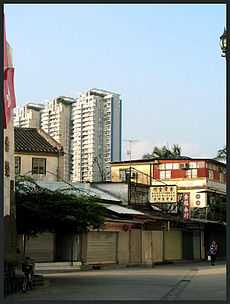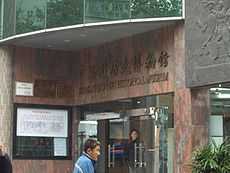Chung Ying Street


Chung Ying Street (Chinese: 中英街; pinyin: Zhōngyīng Jiē; Cantonese Yale: jùng yìng gaài) is a street on the border between Hong Kong and Mainland China, within the border town of Sha Tau Kok (Hong Kong)/Shatoujiao (Mainland China). One side of the street belongs to Hong Kong, and the other belongs to Mainland China.
In Cantonese, Chung means China and Ying England or the United Kingdom. The name is a mark of history of the Second Convention of Peking, a treaty that China under Qing was forced to lease New Territories to Britain in 1899.
The street was a river in 1899. British use the high water mark as the border. The river was too shallow at the section of Sha Tau Kok. It dried before the coming of World War II. The residents on both dried river sides then erected their shops to trade. The dried river then renamed to Chung Hing Street (Chinese: 中興街), and later renamed to Chung Ying Street. The town of Sha Tau Kok flourished for that period of time. After World War II, with large influx of refugees from China, the British Hong Kong government decided to close the border and the town fell within the Closed Area. The border town declined since then.
Chung Ying Street was once a famous place for shopping. In the 1990s, when China was still closed to the world, Chinese tourists visited to buy foreign goods, mostly watches, clothes and jewelry. However, the prosperity has declined in recent years due to the policy that most people from Mainland China can apply to visit Hong Kong directly. Nowadays, Chung Ying Street is transforming to a sight-seeing place of its history. The Chinese government has built a museum about the history of Chung Ying Street to attract tourists again.
See also
| Wikimedia Commons has media related to Chung Ying Street. |
Coordinates: 22°32′47″N 114°13′34″E / 22.5465°N 114.226°E